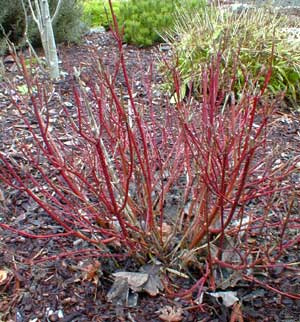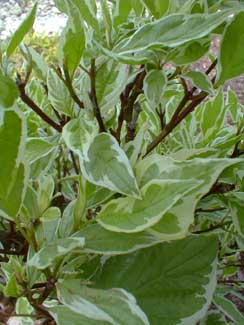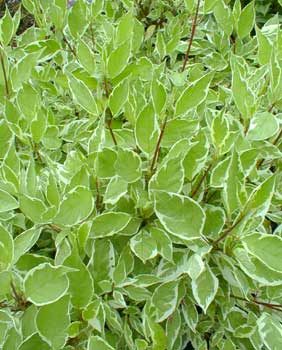
'Bailhalo' or 'Ivory Halo'
Tartarian Dogwood;
aka, Silverleaf Redtwig
or Pagoda Dogwood
"The Wind pursued the little Bush --
And drove away the Leaves
November left -- then clambered up
And fretted in the Eaves."
-Emily Dickinson,
1830-1886
1830-1886
Cornus alba 'Ivory Halo' is variously called by the descriptive common names Silverleaf Tartarian Dogwood, White-margined Redtwig Dogwood, Semi-dwarf Variegated Red Osier or Pagoda Dogwood. The specimen I've photographed is in the garden of friends for whom I've done a bit of landscaping. It was present in the landscape before they bought the property.
This cultivar is a smaller, more compact & mounding form of the taller lankier 'Elegantissima' which is also known as 'Albovariegata' & 'Argentio-marginiata' (although some have suggested 'Siberica Variegata' was once a distinct cultivar, it has no features that could identify it as such).
 'Ivory Halo' aka 'Bailhalo' has extremely stable white-edged mid-green leaves that hold their color throughout summer. It grows three to six feet in comparison to 'Elegantisma' which grows six to ten feet. The spread for 'Ivory Halo' can likewise be three to six feet over time. It is densely enough leafed to be used as a groundcover foliage shrub.
'Ivory Halo' aka 'Bailhalo' has extremely stable white-edged mid-green leaves that hold their color throughout summer. It grows three to six feet in comparison to 'Elegantisma' which grows six to ten feet. The spread for 'Ivory Halo' can likewise be three to six feet over time. It is densely enough leafed to be used as a groundcover foliage shrub.Leaves turn brownish to purple in autumn. Wine-red twigs increase their colorfulness as autumn turns to winter, providing excellent color for the winter garden. Its bared upright red twigs can be particularly striking against snow. Non-variegated redtwig dogwoods are often prized mainly for the winter effect of the twigs & they can seem less striking when in full plain leaf; but 'Ivory Halo' is equally valued as a bright foliage plant.
 For best color it prefers full sun in moist well-draining soil, but will easily tolerate damper soil too. It will do fairly well in dappled shade though twig color will not be as bright & it might not flower. It can be drought hardy especially in shade. It is not as drought hardy in full sun because subject to stress & such problems as leaf-spot.
For best color it prefers full sun in moist well-draining soil, but will easily tolerate damper soil too. It will do fairly well in dappled shade though twig color will not be as bright & it might not flower. It can be drought hardy especially in shade. It is not as drought hardy in full sun because subject to stress & such problems as leaf-spot.Yellowish white flowers occur mainly late spring, though it can produce a few flowers earlier in spring, in summer, or even in early autumn, as its flowers don't seem to pay a great deal of attention to what month it is. These are followed by bluish grey berries. Lone specimens rarely fruit well because redtwigs need to be planted in groups for cross-fertilization. Bees are the primary pollinators, but they also attract butterflies.
To retain maximum color & to keep the shrub from becoming too densely twigged, the limbs can be cut to the ground about once every three or four years, as older twigs are not as brilliantly red. If never pruned, older twigs will settle in with a shiny reddish brown bark that does not get norticeably redder in winter, for the color is strongest in first- & second-year limbs.
However, redtwig will not bloom much if at all in any year that the whole shrub is hard-pruned, since it does not flower on first-year wood.
So instead of hard-pruning the entire shrub once every three or four years, the alternative is to prune no more than one-third of the whole bush every second year at winter's end, ensuring that two-thirds of the shrub is at least two or three years old. It can be difficult to balance maximum winter redness of youngest limbs with maximum flowers & fruits on older limbs, so if a gardener prefers to just let it do what it wants without attention, it'll still be a nice shrub.
See also:
'Spaethii' Yellow-edge Tartarian Dogwood